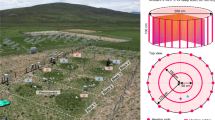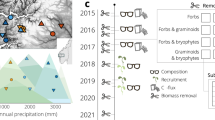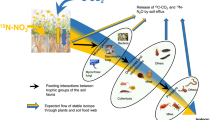Abstract
Climate change has been shown to affect ecosystem process rates1 and community composition2, with direct and indirect effects on belowground food webs3. In particular, altered rates of herbivory under future climate4 can be expected to influence above–belowground interactions5. Here, we use a multifactor, field-scale climate change experiment and independently manipulate atmospheric CO2 concentration, air and soil temperature and drought in all combinations since 2005. We show that changes in these factors modify the interaction between above- and belowground organisms. We use an insect herbivore to experimentally increase aboveground herbivory in grass phytometers exposed to all eight combinations of climate change factors for three years. Aboveground herbivory increased the abundance of belowground protozoans, microbial growth and microbial nitrogen availability. Increased CO2 modified these links through a reduction in herbivory and cascading effects through the soil food web. Interactions between CO2, drought and warming can affect belowground protozoan abundance. Our findings imply that climate change affects aboveground–belowground interactions through changes in nutrient availability.
This is a preview of subscription content, access via your institution
Access options
Subscribe to this journal
Receive 12 print issues and online access
$209.00 per year
only $17.42 per issue
Buy this article
- Purchase on Springer Link
- Instant access to full article PDF
Prices may be subject to local taxes which are calculated during checkout




Similar content being viewed by others
References
Finzi, A. C. et al. Responses and feedbacks of coupled biogeochemical cycles to climate change: Examples from terrestrial ecosystems. Frontiers Ecol. Environ. 9, 61–67 (2011).
Walther, G-R. et al. Ecological responses to recent climate change. Nature 416, 389–395 (2002).
Eisenhauer, N., Cesarz, S., Koller, R., Worm, K. & Reich, P. B. Global change belowground: Impacts of elevated CO2, nitrogen, and summer drought on soil food webs and biodiversity. Glob. Change Biol. 18, 435–447 (2012).
Tylianakis, J. M., Didham, R. K., Bascompte, J. & Wardle, D. A. Global change and species interactions in terrestrial ecosystems. Ecol. Lett. 11, 1351–1363 (2008).
Hillstrom, M., Meehan, T. D., Kelly, K. & Lindroth, R. L. Soil carbon and nitrogen mineralization following deposition of insect frass and greenfall from forests under elevated CO2 and O3 . Plant Soil 336, 75–85 (2010).
Van der Putten, W. H et al. Empirical and theoretical challenges in aboveground–belowground ecology. Oecologia 161, 1–14 (2009).
Norby, R. J., Warren, J. M., Iversen, C. M., Medlyn, B. E. & McMurtrie, R. E. CO2 enhancement of forest productivity constrained by limited nitrogen availability. Proc. Natl Acad. Sci. USA 107, 19368–19373 (2010).
Reich, P. B. et al. Nitrogen limitation constrains sustainability of ecosystem response to CO2 . Nature 440, 922–925 (2006).
Rustad, L. E. The response of terrestrial ecosystems to global climate change: towards an integrated approach. Sci. Total Environ. 404, 222–235 (2008).
Antoninka, A. et al. Linking above- and belowground responses to global change at community and ecosystem scales. Glob. Change Biol. 15, 914–929 (2009).
Johnson, S. N., Staley, J. T., Mcleod, F. A. L. & Hartley, S. E. Plant-mediated effects of soil invertebrates and summer drought on above-ground multitrophic interactions. J. Ecol. 99, 57–65 (2011).
Bais, H. P., Weir, T. L., Perry, L. G., Gilroy, S. & Vivanco, J. M. The role of root exudates in rhizosphere interactions with plants and other organisms. Annu. Rev. Plant Biol. 57, 233–266 (2006).
Van der Putten, W. H. et al. Trophic interactions in a changing world. Basic Appl. Ecol. 5, 487–494 (2004).
Bardgett, R. D. & Wardle, D. A. Herbivore-mediated linkages between aboveground and belowground communities. Ecology 84, 2258–2268 (2003).
Stiling, P. & Cornelissen, T. How does elevated carbon dioxide (CO2) affect plant–herbivore interactions? A field experiment and meta-analysis of CO2-mediated changes on plant chemistry and herbivore performance. Glob. Change Biol. 13, 1823–1842 (2007).
Post, E. & Pedersen, C. Opposing plant community responses to warming with and without herbivores. Proc. Natl Acad. Sci. USA 105, 12353–12358 (2008).
Staley, J. T., Mortimer, S. R., Morecroft, M. D., Brown, V. K. & Masters, G. J. Summer drought alters plant-mediated competition between foliar- and root-feeding insects. Glob. Change Biol. 13, 866–877 (2007).
Mikkelsen, T. N. et al. Experimental design of multifactor climate change experiments with elevated CO2, warming and drought: The CLIMAITE project. Funct. Ecol. 22, 185–195 (2007).
De Graaff, M-A., Van Kessel, C. & Six, J. Rhizodeposition-induced decomposition increases N availability to wild and cultivated wheat genotypes under elevated CO2 . Soil Biol. Biochem. 41, 1094–1103 (2009).
Tate, K. R. & Ross, D. J. Elevated CO2 and moisture effects on soil carbon storage and cycling in temperate grasslands. Glob. Change Biol. 3, 225–235 (1997).
Larsen, K. S. et al. Reduced N cycling in response to elevated CO2, warming, and drought in a Danish heathland: Synthesizing results of the CLIMAITE project after two years of treatments. Glob. Change Biol. 17, 1884–1899 (2011).
Finzi, A. C. et al. Progressive nitrogen limitation of ecosystem processes under elevated CO2 in a warm-temperate forest. Ecology 87, 15–25 (2006).
Pineda, A., Zheng, S-j., Loon, J. J. A. V. & Dicke, M. Helping plants to deal with insects: The role of beneficial soil-borne microbes. Trends Plant Sci. 15, 507–514 (2010).
Anderson, J. P. E. & Domsch, K. H. A physiological method for the quantitative measurement of microbial biomass in soils. Soil Biol. Biochem. 10, 215–221 (1978).
Wamberg, C., Christensen, S., Jakobsen, I., Muller, A. K. & Sorensen, S. J. The mycorrhizal fungus (Glomus intraradices) affects microbial activity in the rhizosphere of pea plants (Pisum sativum). Soil Biol. Biochem. 35, 1349–1357 (2003).
Scheu, S. Automated measurement of the respiratory response of soil microcompartments: Active microbial biomass in earthworm faeces. Soil Biol. Biochem. 24, 1113–1118 (1992).
Ronn, R., Ekelund, F. & Christensen, S. Optimizing soil extract and broth media for MPN-enumeration of naked amoebae and heterotrophic flagellates in soil. Pedobiologia 39, 10–19 (1995).
Whitehead, A. G. & Hemming, J. R. A comparison of some quantitative methods of extracting small vermiform nematodes from soil. Ann. Appl. Biol. 55, 25–38 (1965).
Van Soest, P. J. Nutritional Ecology of the Ruminant 140–155 (Cornell Univ. Press, 1994).
R—A Language and Environment for Statistical Computing (R Foundation for Statistical Computing, 2011); available at http://www.R-project.org.
Acknowledgements
We thank V. Kann Rasmussen Foundation (through the CLIMAITE project), Air Liquide and Dansk Olie og Naturgas energy for technical support. C.S. and D.G. were supported by the infrastructure ‘Increase’, financially supported by the European Union.
Author information
Authors and Affiliations
Contributions
K.S. and C.S. contributed equally to this manuscript. C.S., S.C. and C.B wrote the manuscript. K.S. and S.C. planned and initiated the study. K.S., D.G., C.S. and S.C. collected the data and had initial discussions of their implication. C.S. and S.C. carried out all statistical analyses. T.N.M. was in charge of the field study. All authors discussed the analysis and results and commented on the manuscript text.
Corresponding authors
Ethics declarations
Competing interests
The authors declare no competing financial interests.
Supplementary information
Rights and permissions
About this article
Cite this article
Stevnbak, K., Scherber, C., Gladbach, D. et al. Interactions between above- and belowground organisms modified in climate change experiments. Nature Clim Change 2, 805–808 (2012). https://doi.org/10.1038/nclimate1544
Received:
Accepted:
Published:
Issue Date:
DOI: https://doi.org/10.1038/nclimate1544
This article is cited by
-
Extreme rainfall events alter the trophic structure in bromeliad tanks across the Neotropics
Nature Communications (2020)
-
Effects of acute and chronic temperature changes on the functional responses of the dogfish Scyliorhinus canicula (Linnaeus, 1758) towards amphipod prey Echinogammarus marinus (Leach, 1815)
Environmental Biology of Fishes (2017)
-
Elevated CO2 increases fungal-based micro-foodwebs in soils of contrasting plant species
Plant and Soil (2017)
-
Enhanced carbon release under future climate conditions in a peatland mesocosm experiment: the role of phenolic compounds
Plant and Soil (2016)
-
Interactive effects of multiple climate change variables on trophic interactions: a meta-analysis
Climate Change Responses (2014)



